
|  |
 General Electric
General Electric
Carousel of Progress
|
“There’s a
great big beautiful tomorrow,
shining at the end of every day.”
|
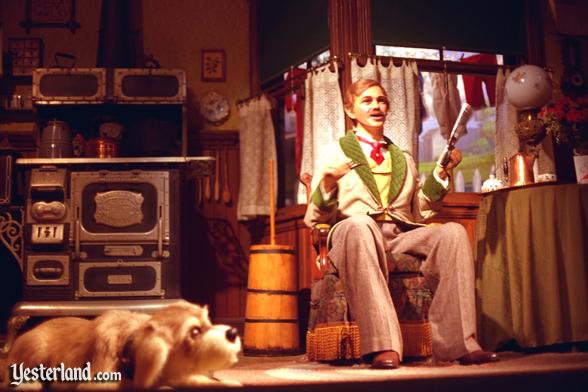
Act 1: “Well, the robins are back.
That’s a sure sign of spring.
What year is it?
Oh, before the turn of the century.
And believe me, things couldn’t be any better than they are today.”
Free
Join everyone’s favorite Audio-Animatronic family—Father, Mother,
daughter Jane (and her unnamed brother), Grandma, Grandpa, and,
of course, Cousin Orville—for a very entertaining and enlightening
“spin” through time.
You enter your 240-seat theater section in the first of its six positions,
while guests in five other sections enjoy other parts of the presentation.
After several minutes, the theater rotates to another position.
You’ll stop for four theatrical acts.
Your final stop is the Speedramp to Progress City.
Go up the ramp to the incredible 6,900-square-foot model of Walt Disney’s
vision of the city of tomorrow.
There, the show’s dialog continues as lighting identifies various parts of
Progress City.
Let’s “listen” to a brief excerpt from each act:
- Introduction
- Father: “Welcome to the General Electric Carousel of Progress.
Now most carousels just go ’round and ’round, without getting anywhere.
But on this one, at every turn, we’ll be making progress.”
- Act 1 (just before 1900)
-
Mother:
“But with my new wash-day marvel, it takes only five hours to do the wash.
Imagine!”
Father: “That’s right, folks.
Now Mother has time for recreations like, uh...”
Mother: “Like canning, and polishing the stove?”
- Act 2 (twenty years later)
-
Father: “Well, the days of lugging heavy, hot irons from
an old stove to an ironing board are gone forever.
And with an electric iron and electric lights, Mother has something to do
to fill in her evenings.
Now it’s no problem at all to get my collars smooth, right Mother?”
Mother: “Yes, dear.”
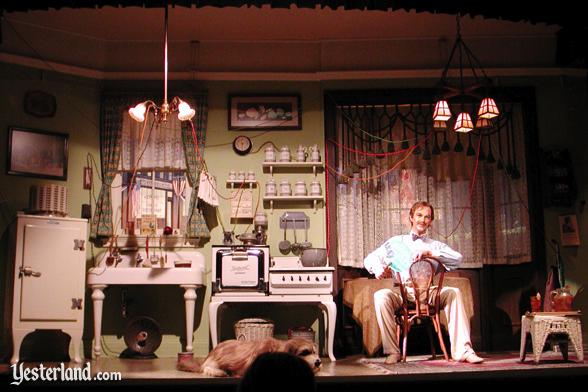
Act 2: "Whew! Hottest summer we’ve had in years.
Well, we’ve progressed a long way since the turn of the century, twenty years ago.
But no one realized then that this would be the age of electricity.
Everyone’s using it... farmers, factories, whole towns!"
- Act 3 (the 1940s)
-
Father: “Radios and automatic record players are now combined in one unit.
And Grandma has a new hearing aid.”
Grandma: “Hmmm?”
Father: “Nothing, Grandma.”
Grandma: “Oh, I thought you said I had a new hearing aid.”
- Act 4 (some time beyond 1967)
-
Father: “Our television console is more than just a TV set.
It has a built-in video tape recorder.”
Mother: “Now we can record our favorite shows for viewing at a more
convenient hour.
And television programming is so much improved today.”
Father: “What Mother means is, they’re still shooting it out,
but now it’s in color.”
- Progress City
-
Mother: “Today our whole downtown is completely enclosed.
Whatever the weather is outside, it’s always dry and comfortable inside.”
Father: “General Electric calls it a climate-controlled environment.
But Mother calls it...”
Mother: “A sparkling jewel.
Now far off to your right, we have a welcome neighbor...”
Father: “Our GE nuclear power plant, dear.”
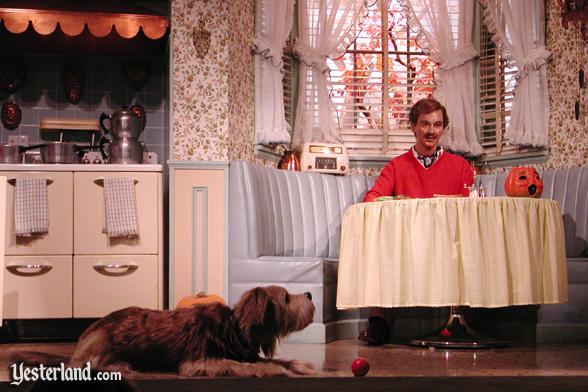
Act 3: “Well it’s
autumn again, and the kids are back in school. Thank goodness! Now we’re
in the frantic forties, and it’s amazing how today’s household
appliances are helping to take over the hard work, like our new electric
washing machine. It does about everything but hang up the clothes.”
In the 1950s, Walt Disney developed a concept for an attraction showcasing
progress in American homes as the centerpiece of Edison Square, a new “land”
planned for Disneyland.
Edison Square was to be the urban residential neighborhood adjacent to the
commercial Main Street, USA.
The site was directly behind the Plaza Inn (which was Swift’s Red Wagon
Inn back then), between Main Street and Tomorrowland.
Guests would walk from theater to theater
inside a horseshoe shaped structure, to experience:
- American home, pre-electricity
- American home, advent of electricity
- Contemporary living
- The electronic age
But Edison Square was never built.
By 1964, the concept had become Progressland, developed by Walt Disney
for the General Electric pavilion at the New York World’s Fair.
Guests stayed in their seats as an outer ring of six theaters moved around
a fixed, circular section.
While guests were entering into one theater and exiting from another, guests
in the other four theaters were watching the tireless Audio-Animatronic actors
in the four acts of the show.
It was a huge hit with audiences in 1964 and 1965.
When the Fair ended, Walt Disney had a perfect attraction to anchor Disneyland’s
planned New Tomorrowland.
Sadly, Walt Disney died in December 1966.
He never saw the July 1967 opening of Disneyland’s New Tomorrowland with its
transplanted General Electric Carousel of Progress.
In Disneyland, the show concluded with a fifth act on the upper level
of the Carousel Theater, featuring the detailed model of Progress City.
It was no secret that Walt Disney intended to build a similar city on land that
he had secretly acquired in central Florida.
Thus, Progress City would provide a preview of Walt Disney’s vision for an
Experimental Prototype Community of Tomorrow (EPCOT).
After running more than six years in Disneyland, the Carousel of Progress
show closed permanently in 1973.
The Carousel Theater was possibly the most guest-friendly, efficient attraction mechanism ever.
The six theater sections on the lower level served six audiences simultaneously, with a new show starting every four minutes.
It was an ingenious way to offer a fairly long show in a small, intimate theater, yet with high capacity and quick load times.
In comparison, a theater like the American Adventure at Epcot relies on one large theater—so if you miss a show, you’ll have to wait a half hour for the next one.
|
|
From 1974 to 1988, the bottom level of the Carousel Theater at Disneyland housed
America Sings.
Again, Disney made use of the ingenious theater configuration.
The upper level became the Super-speed Tunnel (and later the World of Tron) for the guests of the PeopleMover.
Then, for many years, the lower level served as office space.
As part of the 1998 renovation of Tomorrowland,
the Carousel Theater building became the West Coast home of Epcot’s Innoventions.
This time there were no theaters.
Innoventions is a two-story exhibit hall—but for some inexplicable reason, it still uses batch loading, and the outer core of the lower level still rotates.

|
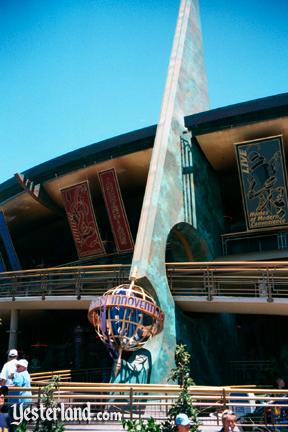
The former Carousel Theater in
Disneyland is now Innoventions.
|
|
In 1975, the Carousel of Progress show found a new home in the Magic Kingdom
at Walt Disney World.
In the move to Florida, the show lost its Progress City act and its
original theme song.
In 1985, General Electric dropped its sponsorship.
A 1994 renovation restored the original theme song and celebrated Walt Disney’s
personal role in the creation of this attraction.
Not only were Acts 1, 2, and 3 nostalgic, the entire attraction was presented as a
nostalgic tribute to Walt Disney.
The show was even renamed to Walt Disney’s Carousel of Progress.
As they had done several times before, Disney’s Imagineers updated Act 4 to show newly emerging technologies.
(Grandma really seemed to enjoy her virtual reality helmet.)
But there was no hiding that the flow of the show was suffering.
When the show originally opened in New York, each new act represented a twenty
year jump.
But now, Act 4 represented a jump of almost 60 years to a different
“turn of century.”
On October 29, 2001, the Orlando Sentinel reported,
“Carousel of Progress, which first appeared at the 1964 New York World’s Fair,
is now shuttered.
Although there isn’t a ‘closed’ sign on the futuristic building,
the attraction has been
taken off Magic Kingdom guide maps and the daily bulletin board on Main Street.”
It appeared that Walt Disney’s Carousel of Progress had welcomed its final
audience—ironically just as Walt Disney World began the “100 Years of Magic”
celebration, honoring Walt Disney one hundred years after his birth.
However, during the 2001 holiday season, the Carousel of Progress reopened for
a few weeks, closing once again in January 2002.
The pattern repeated for peak periods in 2002 through 2006.
So, for now, if you visit the Magic Kingdom during a busy season,
there’s a good chance you’ll find the Carousel of Progress operating.
Take advantage of the opportunity, because it’s likely that the Carousel
of Progress will come to a permanent standstill one of these days.
You can still catch a glimpse of the Progress City model at Walt Disney World,
even though it was never part of the Carousel of Progress show in Florida.
A portion of the model is installed in the Stitch’s Great Escape! building.
The only way to see it is to take the Tomorrowland Transit Authority.
Unfortunately, you move by very quickly, so there’s almost no opportunity to
examine the details and to think about Walt Disney’s EPCOT.
By the way, EPCOT was never built.
Sure, EPCOT Center (now called Epcot), a delightful theme park, opened in 1982.
But the real city of EPCOT that Walt Disney visualized never happened.
However, The Walt Disney Company started (and sold off) a very different real city
called Celebration, Florida.
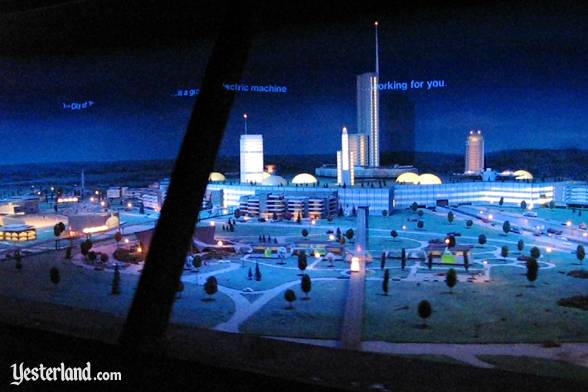
Tomorrowland Transportation Authority
narrator: “The Tomorrowland Metro Retro Historical Society presents Walt
Disney’s twentieth century vision of the future. These models represent what
Walt believed to be the perfect community in which to work, live, and play.”
If you’d like to see more about the Carousel of Progress at Disneyland, take a look at the General Electric Publicity Photos.
© 2007 Werner Weiss — Disclaimers, Copyright, and Trademarks
Updated May 8, 2007.
Photograph of Carousel of Progress “Act 1”
by Michael L. Witczak, 1995.
Photograph of Carousel of Progress “Act 2”
by Werner Weiss, 2002.
Photograph of Carousel of Progress “Act 3”
by Werner Weiss, 2002.
Note: The pictures for Acts 1, 2, and 3 were taken at Walt Disney World in Florida—not at Disneyland in California.
Photograph of Innoventions at Disneyland (the former Carousel Theater);
by Werner Weiss, 2000.
Photograph of Progress City from Tomorrowland Transit Authority at the Magic Kingdom in Florida;
by Werner Weiss, 1999.
|
|